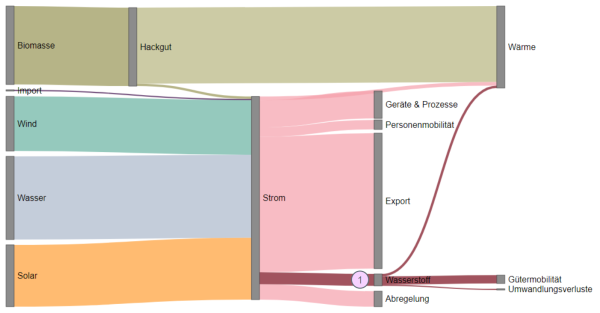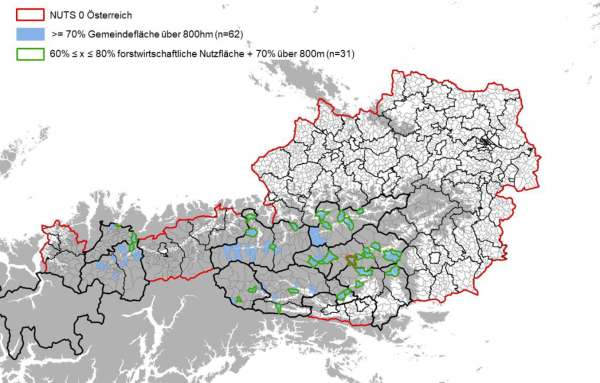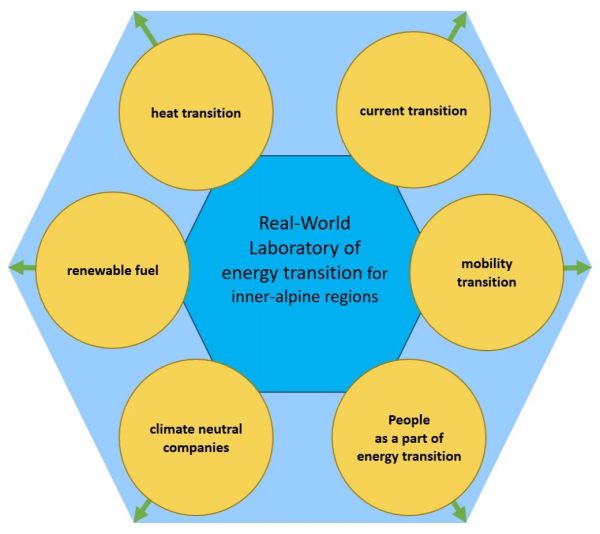# Murau : Real-World Laboratory of energy transition for inner-alpine regions
Short Description
While the realization of the energy transition is amajor challenge for each region in itself, inner-Alpine regions face a kay challenge, without which central, overall political development issues in Europe cannot be solved in a climate-neutral manner: Further urbanization in Europe will only be possible in a climate-neutral manner if the energy question for cities is solved by and together with rural regions.
With the transition from fossil fuels to renewables, inner-Alpine regions are given the same role in the supply of renewable energy as they are now in the supply of drinking water or food. This also results in the vision in Murau: 100% real climate-neutral and needs-based energy export region for the metropolitan areas.
Right from the start, the energy vision for Murau has taken a clearly vision-oriented approach: Based on the vision, we have consistently looked at which steps to take towards the goal along development axes - each with the available possibilities of a region and its actors. With a living lab, Murau can increasingly become a region in which the energy future is implemented as a prototype for all inner-Alpine regions and puts us in the position of an export region: we export implementation knowledge, planning knowledge, possibly even technological knowledge and, of course,more and more electricity generated from renewable sources as needed for other regions – especially cities that cannot achieve the energy transition at the same speed.
The aim of the project was to create structures for the later living lab inMurau. As a lab, together with partners for inner-Alpine regions, one wants to show prototypically that climate neutrality is already possible all year round and that regions can become reliable energy exporters, especially for the metropolitan areas. The living lab Murau builds on the solutions already implemented in the region and develops them further for broad implementation with regional players and national technology partners. Another important innovative aspect lies in the approach of the six development axes (heat transition, electricity transition, mobility transition, renewable energy for mobility, climate-neutral companies and people as part of the energy transition, along which this vision is to be implemented.
In the course of the project, a stakeholder process was set up, which on the one hand discussed the analyzes and results brought in by scientific partners and on the other hand served to activate the stakeholders. The stakeholders identified numerous real tests (first demonstration projects), which were subsequently located along the development paths for the regional energy systemand combined them into lead projects. The aim of thesemeasures is to meet future challenges of decarbonization. In addition to turning away from fossil fuels, these include the expected electrification of mobility and heat supply.
The power sector is primarily dominated by hydroelectric generation capacity. Electricity production
is currently around 400 GWh/a and consists of around 325 GWh/a hydropower, 65 GWh/a wind and
10 GWh/a solar PV. It is evident that there is still strong potential for expansion, especially in the area of solar PV generation. In terms of the balance sheet, monthly requirements can be covered at any time with local resources. However, especially in the months of January, February and March, there are often times when it is necessary to obtain electricity from the higher-level grid. The provision of heat in the Murau region consists essentially of biomass, heating oil and, to a lesser extent, heat pumps. The energy requirement in the mobility sector is around 220 GWh per year, with fossil fuels being used almost exclusively. Future expansion paths will mainly develop along the following technology axes:
- Expansion of solar PV and wind capacities
- Electrification of mobility through electromobility
- Electrification of heat through heat pumps
- Battery storage & electrolysis
Since the capacities to the higher-level grid are limited and a greater expansion of volatile renewable energy sources is to be expected, the issue of flexibility will play an increasingly important role. The stakeholders in Murau want to focus primarily on sector coupling in the direction of mobility and heating.
In addition to considerations about the future business model of the real laboratory, the supporting tasks also included a transferability analysis, an approach to knowledge transfer, test logic for the living lab and an overall system solution. In Murau, this is derived from an approach for the 100% supply of the energy system with regional renewable energy sources at any time of the year. There are different approaches to creating a so-called "100% renewable system power plant".
Subsequently, these findings are to be used to found the living lab in Murau and to submit the first (flagship) projects. The exploratory project not only produced interesting results. It has also realigned the stakeholder process and brought new organizations on board that are essential for the living lab at a later stage.
Project Partners
Project management
Holzwelt Murau - Mag. Erich Fritz
Project- bzw. Cooperationspartners
- AIT Austrian Institute of Technology GmbH
- HyCentA Research GmbH
- Biowärme Lachtal GmbH
- Murauer Stadtwerke GmbH
- Marktgemeinde Neumarkt Versorgungsbetriebsges.m.b.H.
- Elektrowerk Schöder GmbH
Contact Address
Holzwelt Murau
Mag. Erich Fritz
Bundesstraße 13a
A-8850 Murau
Tel.: +43 (3532) 20000 11
E-Mail: erich.fritz@holzwelt.at
Web: www.energieregionmurau.at




